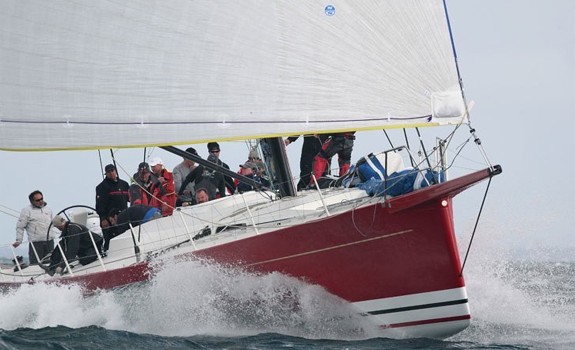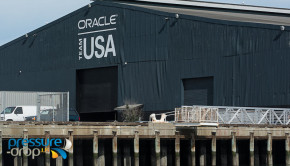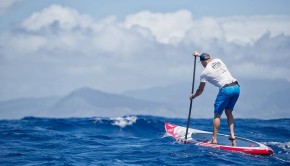Peter Isler – Attrition for cause
Published on March 22nd, 2011
 Two-time America’s Cup winner Peter Isler’s newest book, “Peter Isler’s Little Blue Book of Sailing”, was released this week by Wiley. Peter was going to celebrate the occasion by racing from SoCal to Mexico, but instead he shares a report on why he’s on the sidelines.
Two-time America’s Cup winner Peter Isler’s newest book, “Peter Isler’s Little Blue Book of Sailing”, was released this week by Wiley. Peter was going to celebrate the occasion by racing from SoCal to Mexico, but instead he shares a report on why he’s on the sidelines.
I’m sitting at home in San Diego logging into the Newport Harbor YC’s website to follow the 800-mile Newport Beach to Cabo San Lucas race instead of sailing downwind on John and Susie MacLaurin’s 70-foot Pendragon VI. We were on the final stretch run to the finish, but dropped out due to a breakdown in the rough conditions encountered on the second day of the race. However, we were not alone in calling it quits.
Of the 15 boats that started the race on Saturday (the “small boats” starting the race on Friday missed the storm), 9 withdrew. Broken parts, broken sailors, and one dismasting have all been reported from the sailors who have made it back to shore. The attrition can be attributed to some pretty nasty wind and wave conditions as a cold front and associated low pressure ripped through Southern California on Sunday.
But over 50% of Southern California’s best big boats (and one of top 70 footer from the East Coast) dropping out? Since returning to shore and talking to sailors, I’ve had some time to think about the high rate of bail outs and have amended my first impression (that West Coast sailors and boats are spoiled with normally great reaching and downwind races and they are not ready for a good ol’ upwind slog).
Here are the facts: While the small boat fleet that got away on Friday was able to get far enough south to avoid the touch of the approaching deepening low, the forecast showed that after 12 hours of relatively light air, the Saturday starters were bound to “enjoy” about 24 hours of upwind sailing in 25+ knots before the front passed by and the winds came aft. NOAA had already posted a Gale Warning for winds over 34 knots.
The forecast was pretty much spot on and by dawn on Saturday, the big boat fleet was beating into increasing 20 knot winds about 50 miles south of the border. Initially conditions were pretty manageable. There was a huge 2.5 meter NW swell – and the building SE winds had yet to really kick up much in the way of a wind driven sea state. At 9AM on Pendragon, our jib cunningham broke and we suffered some headstay damage. With the forecast of at least 15 more hours of windy windward work, we chose to turn north and beat the front into San Diego.
By the time we made it into the harbor, there were reports of other withdrawals, with Bella Mente, Hap Fauth’s internationally renowned 69 footer from the east coast, having been dismasted. In the ensuing 24 hours, the picture came clearer. While we bailed out before the wind driven waves had built up, in a few more hours, the 25-30 knot winds blowing over the open ocean had made for some good sized waves that were stacking up against the NW swell and creating a really nasty sea state that further took its toll on equipment and the morale of the sailors. Dave Ullman, who was aboard Brack Ducker’s Santa Cruz 70 Holua, said that conditions were plenty rough – enough to give them cause to turn back to San Diego too.
Sailing upwind in 25-30 knots doesn’t sound like a race-ender. So why the attrition? There really are very few races where you are in over 30 knots of wind in the open ocean for 24 hours or more. Inshore and coastal racing is one thing, but these Southern California races are sailed in the biggest ocean on the planet – and when the wind comes on the nose, the fetch is significant and the waves can become big. Stack those up against the typical NW to SE bound swell and you have a sea state that is much, much worse than the “25-30 knots” that we sailors might picture in our minds’ eye. I honestly can’t think of many races I’ve ever sailed in where we sailed upwind in 30 knots with a virtually unlimited fetch. Usually the beat is either shorter in duration, or if it is a long upwind course, the fetch is much less. Sea state can contribute greatly to the shock loads on a boat.
Certainly the fact that the Southern California big boat fleet is optimized for downwind and reaching races contributed to the attrition, but I don’t believe it was the primary reason. It was really, really rough and windy out off the northern Baja coast on Sunday. One of the most successful contemporary international ocean racing boats – Bella Mente – lost their rig. Sailors with significant international offshore and even around the world race experience were on some of the boats that dropped out.
Let’s face it, from a seamanship standpoint, sailors should be given credit for putting safety before results. I still think back to the Middle Sea Race a few years ago. Aboard Tom Hill’s 75 footer Titan, we decided to drop out only a few hours into the race because the forecast showed hurricane force winds would hit us as we sailed along a lee shore halfway through the race. My friends on George David’s Rambler continued in the race and set the course record, but this was a boat that had just competed in a windy Transatlantic Race and was fully ocean race ready. Our near sister ship, Loki was abandoned and destroyed after breaking the rudder about 24 hours after we dropped out.
Not every ocean racing boat is ready to “race” in really rough weather (although they can certainly sail in it), and I certainly don’t fault any sailor who decides that when they are no longer racing – or the forecast predicts conditions that would endanger the boat, its equipment or crew – that it is time to head home. I can’t wait to hear some sea stories from some of my friends on boats in the Saturday start fleet that did continue in the race. But I’ve already heard enough from the guys who headed back to shore to know that it was very rough, boat breaking weather out there.
Could Pendragon VI have continued in the race? Yes, but with a forecast of deteriorating conditions for another 15 hours, the mast would have been at risk because of the headstay damage and we certainly would no longer be “racing” the boat. That’s a good enough reason in my book to bail out.









 We’ll keep your information safe.
We’ll keep your information safe.